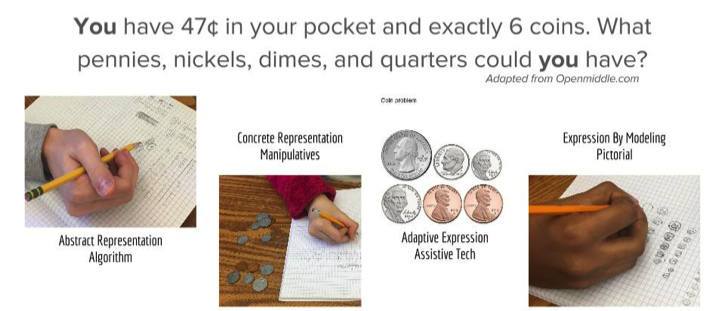By
Andrew Gael, posted June 6, 2016 —
For years, special education mathematics
classes have focused on rote computation and money skills with steadfast tunnel
vision (Browder
et al. 2008). The
meta-analysis by Browder and her colleagues reveals that about 93 percent of
studies of mathematics classes for students with significant cognitive
disabilities focused on the NCTM domains of Numbers and Operations as well as Measurement,
specifically money and time. No wonder students with disabilities are “failing
standardized tests” (Samuels
2016). Their classes focus on just one strand of mathematical proficiency: procedural fluency.
However, greater importance has recently been
placed on the other strands of mathematical proficiency: conceptual
understanding, strategic competence, adaptive reasoning, and productive
disposition. Why aren’t special education math classes also making this shift?
This lack of progress is creating an inequitable landscape where students with
disabilities are not given the opportunity to develop into mathematically
proficient students. Small addresses this issue in her book Good Questions: Great Ways to
Differentiate Mathematics Instruction:
Although many teachers of language arts
recognize that different students need different reading materials, depending
on their reading level, it is much less likely that teachers vary the material
they ask their students to work with in mathematics. The math teacher will more
frequently teach all students based on a fairly narrow curriculum goal
presented in a textbook (2012, p. 1).
How can we do this? How can we broaden our
scope for students with disabilities but still work on the skills that they
need to be successfully independent adults? By opening the middle of math tasks
in special education classes. Too often students with disabilities are left at
the first level of Webb’s
depth of knowledge (DOK).
Problems like 44 + 27 =___ and “If you have 2 dimes and 3 pennies, how many
cents do you have?” do not give students with disabilities the opportunity to
develop into mathematically proficient students. Problems that Kaplinsky and Johnson refer to as open-middle
problems will help develop
mathematically proficient students. Open-middle problems usually have multiple
solution pathways, a procedural look, a puzzle-like complexity, and a seemingly
simple solution, but often a more complex optimal answer. Take this open-middle
problem created by Domina and Kaplinsky to meet a second-grade
standard:
Make 47¢ using
exactly 6 coins with either quarters, dimes, nickels, or pennies.
This
problem is considered DOK level 3 and allows students to use and develop all
strands of mathematical proficiency. Students with disabilities can also
express their knowledge and understanding in different ways. Here is an example
from our presentation at this
year’s NCTM Annual Meeting and Exposition in San Francisco:

Each of
these students used a different form of expression (from left to right:
algorithms, manipulatives, assistive tech, and drawings) to demonstrate their
understanding of the problem. Because this problem had an open middle, students
were not only allowed but also encouraged to explore different representations
and tools to use to solve the problem.
Often
problems like this are considered “too hard” for “lower-level students,” but as
Wees writes, these kinds of labels and
expectations can have negative effects on our students, and
this is especially true for students with disabilities. I am not advocating
that special education math classes stop teaching computation and money skills,
but if you do, please make sure that students have opportunities for to develop
all the strands of mathematical proficiency. When you keep your expectations
high, your students with disabilities just might meet them!
What
tasks that you already do in special education classes can be opened, in either
the middle or the end, to encourage higher levels of depth of knowledge?
References
Browder, Diane M., Fred Spooner, Lynn Ahlgrim-Delzell,
Amber A. Harris, Shawnee Wakemanxya. 2008. “A Meta-Analysis on Teaching
Mathematics to Students with Significant Cognitive Disabilities.” Exceptional Children 74 (4): 407–32.
Small, Marian. 2012. Good
Questions: Great Ways to Differentiate Mathematics Instruction. New York:
Teacher’s College Press.
 Andrew Gael has worked in education for more than
ten years and as an educator of students with disabilities for the last six. He
was born and raised in New York City, receiving his Master’s in Education
from Brooklyn College. Gael now teaches math at the Cooke Center Academy, a
school for students with developmental, learning, and physical disabilities in
Manhattan. He has spoken nationally to advocate for equitable access to the
highest quality math instruction for the typically under-served student
population of students with disabilities. He writes about the intersection of
math education, special education, and disability rights on his blog, The
Learning Kaleidoscope.
Andrew Gael has worked in education for more than
ten years and as an educator of students with disabilities for the last six. He
was born and raised in New York City, receiving his Master’s in Education
from Brooklyn College. Gael now teaches math at the Cooke Center Academy, a
school for students with developmental, learning, and physical disabilities in
Manhattan. He has spoken nationally to advocate for equitable access to the
highest quality math instruction for the typically under-served student
population of students with disabilities. He writes about the intersection of
math education, special education, and disability rights on his blog, The
Learning Kaleidoscope.